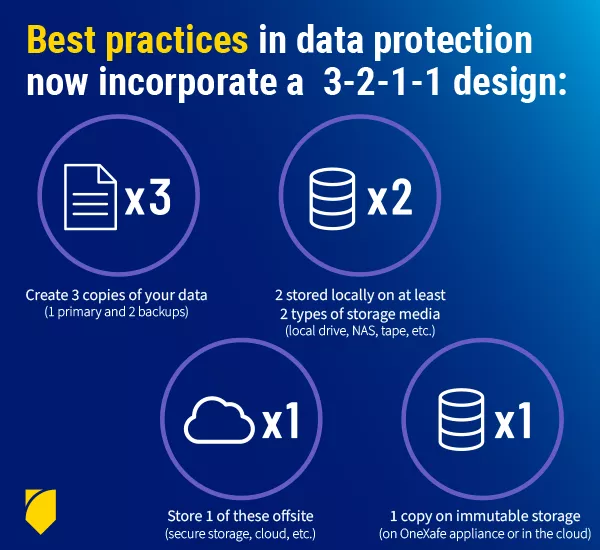Ransomware Protection for an Impenetrable Business
A proactive, multi-layered approach prevents, protects, and immunizes backup data from ransomware and other cyberattacks. Immutable backup storage—on-premises with OneXafe appliances or in the cloud with AWS Object Lock—safeguards data from malicious exploits. Threats are neutralized while data loss and downtime are eliminated. You carry on business as usual.
Are You Ready for Ransomware?
Find out when your customers will “walk away” or abandon your company for a competitor. Learn strategies for gaining buy-in from key decision makers for ransomware prevention software.
Advanced Ransomware Protection for the Modern Infrastructure
New research reveals that nearly 60 percent of consumers will likely avoid doing business with your organization if you experience a cyberattack this year. With malicious threats reaching epidemic proportions, it’s time to fight back.
Arcserve helps you eliminate the complexity of discrete data security and protection plans with total integration of ransomware and malware prevention, backup, and disaster recovery for a unified first and last line of defense against cyberattacks.
A PROACTIVE RANSOMWARE PROTECTION STRATEGY
To become truly cyber-ready, you need a proactive approach to data security. One that transforms your ransomware backup strategy from piecemeal and complex to integrated and simple.
Infrastructures become resilient
Threats are detected and prevented
Disaster recovery (DR) and high availability protect thoroughly from data loss
How Ransomware Works
Ransomware is a malicious software designed to deny access to your computer systems or data until a ransom is paid. It can stop your business dead in its tracks, or go a step further, and threaten to exfiltrate and expose your data.
Commonly, ransomware is spread through:
Emails and text messages containing links that will download malware or an attachment containing malware.
Websites and malvertising made with the sole purpose to draw in users and get them to click on a malicious link or download.
Social media and mobile apps that may seem connected to trusted sources but are designed to transfer a virus either directly within an application, or the next time the mobile device is connected to a computer.
Ransomware Preparedness
Beyond baiting users to unknowingly download ransomware, cyber criminals gain access to systems over the internet while no one is around. It’s constantly evolving, making your ransomware backup solution more important than ever. Check your ransomware readiness with this assessment.
Neutralize Ransomware for Good
Protect your business from unrecoverable financial and reputational loss. System protection combined with artificial intelligence (AI) secures data against cyberattacks, while battle-tested backup and DR prevents data loss from major disasters, human errors or other unplanned outages.
Detect and Prevent
Sophos Intercept X Advanced secures your on-premises, cloud, and SaaS-based backups from the widest range of threats with signature-based and signatureless malware detection, a deep learning neural network, anti-exploit technology, CryptoGuard anti-ransomware and WipeGuard technologies.
Protect
Heterogeneous, image-based technology protects to and from any target, combining enterprise-ready features without the complexity of traditional enterprise solutions. Scale up and down on demand, and turn on and off capabilities without forklift upgrades.
Neutralize
A proactive, multi-layered approach prevents, protects, and immunizes backup data from ransomware and other cyberattacks. Threats are neutralized while data loss and downtime are eliminated. You carry on business as usual.
The last ransomware attack was unbelievably major. The last one hit 45 different servers, spread itself, and just went crazy. … I certainly wouldn’t do anything but Arcserve. I can’t imagine anything else being any better.
Advanced Threat Detection
Advanced machine learning detects both known and unknown malware, without relying on signatures, to secure your backups from any threat. CryptoGuard and WipeGuard use behavioral analysis to stop never-before-seen ransomware and boot-record attacks.
Secure Backups
Provides immutable backups—stored on-premises or in the cloud—across your entire infrastructure with comprehensive support for cloud, local, virtual, hyperconverged, and SaaS-based workloads.
Unrivaled Simplicity
Eliminate standalone, discrete products for cybersecurity, DR, and application availability. Quickly protect on-premises, cloud, and SaaS-based workloads to achieve IT resilience faster.
Rapid Response
CryptoGuard and WipeGuard use behavioral analysis to rapidly stop never-before-seen ransomware and boot-record attacks.
Immediate Restore
Safely spin up copies of physical and virtual systems onsite and offsite, or in private and public clouds. Rollback applications to a point in time before a ransomware event.
Limitless Scale
Leverage software, appliances, hybrid cloud services, or a mix of all to scale up or down to meet your unique needs. Expand storage seamlessly—adding one drive at a time, or multiple nodes within a cluster—without any application configuration changes.
Immutable Storage
Safeguard your backups from ransomware attacks or accidental modification with immutable storage, on-premises with a OneXafe NAS appliance or in the cloud with AWS Object Lock.
Arcserve UDP Secured by Sophos
Unified data protection for every type of workload, on- or off-premises, that reduces management time and complexity.
Arcserve Appliances Secured by Sophos
All-in-one backup, DR, and cybersecurity for a first and last line of defense against cyber-attacks.

Arcserve Cloud Hybrid Secured by Sophos
Fully-integrated cloud backup, cybersecurity, and disaster recovery extension to Arcserve data protection software and appliances.
Arcserve SaaS Backup
Protect SaaS application data from ransomware attacks and other disasters.
OneXafe Immutable Storage
Scale-out storage for high-performance unstructured data and backup targets, with immutable object store to safeguard data.
